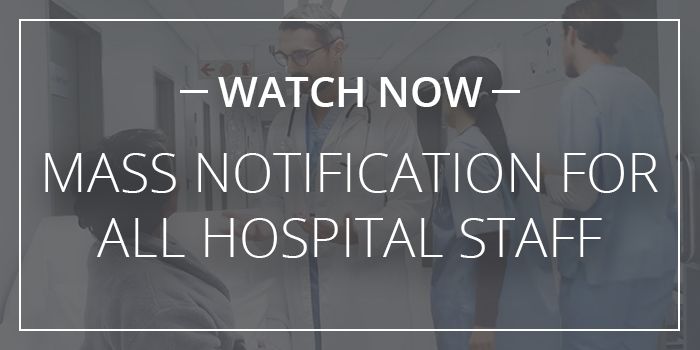Using Mass Notification in Every Healthcare Role
In healthcare, providing a safe environment ensures smooth operations and excellent patient care. That goal can only be achieved with strong communication, but without the right tools in place, healthcare organizations can waste precious time trying to information into the hands of the people who need it. While implementing a mass notification system may seem like a challenge, both in terms of time and resources, healthcare organizations that deploy it for use across all their departments will get more value out of their investment. Whether it’s doctors and nurses trying to help patients, security trying to protect visitors and staff, or facilities and IT teams making sure everything within a building continues to run as it should, they should all be able to leverage a mass notification tool to carry out their duties. Watch the video below and continue reading to see how mass notification can benefit every member of the healthcare staff.
Doctors and Nurses
The primary use case for mass notification systems in healthcare is to help doctors and nurses deliver excellent patient care. This is done by sending mass notifications to on-site and mobile devices to request assistance for situations like “Code Blue” emergencies. Given the configuration options available within a mass notification tool, alerts can be sent to specific groups, floors, or wings of a building. This means only relevant parties are notified so they can respond as quickly as possible.
The other consideration is staff safety. Panic buttons installed on computer desktops, IP phones, mobile phones via an app or integrated with wearable badges can all provide easy-to-activate and discrete methods for asking for assistance with an unruly patient or visitors. With a badge or app, security team members will receive the staff member’s name and location so they can send assistance. This can be especially usual for staff that work odd hours and may need to return to their cars alone at night in a parking garage away from the building.
Security
Like any organization, healthcare facilities need to be prepared for incidents that impact daily operations. This could be a violent intruder, active shooter, or even locating a lost child. Security teams can leverage mass notification to trigger lockdowns and announcements to alert visitors and staff of ongoing incidents. They can also use mass notification to survey people within their organization to determine who is safe and who needs assistance. When an incident has ended, they can send out “All Clear” alerts to let people know the danger has passed and normal activities can resume.
IT
While healthcare IT teams will be called upon to help implement a mass notification system and integrate it with existing technology, including IP phones, digital signage, desktop computers, mobile phones, overhead paging systems, and more, they can also get value from this tool after implementation has been completed. Setting up automated alerts and using cloud-based notifications can let IT know when critical systems become inoperable while still being able to communicate with the rest of the organization. This can minimize downtime and reduce confusion as they work to resolve the issue.
Facilities and Maintenance
Healthcare buildings rely on their facilities teams to keep buildings clean and orderly. They can use mass notification to monitor for and send alerts about hazardous spills, HVAC issues, or severe weather that may impact operations. Communicating about areas to avoid and conditions to be aware of can minimize risk so no one is put in harm’s way.
These are just a few of the ways these healthcare roles can benefit from mass notification. If your organization is considering a mass notification system, be sure to download a free copy of our buyer’s guide.
